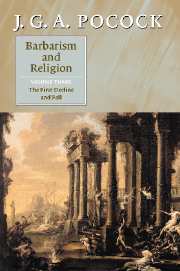Book contents
- Frontmatter
- Contents
- Acknowledgements
- Note on usages
- List of abbreviations
- Introduction
- PROLOGUE
- 1 Gibbon's first volume: the problem of the Antonine moment
- PART I THE FIRST DECLINE AND FALL: ANCIENT PERCEPTIONS
- PART II THE AMBIVALENCE AND SURVIVAL OF CHRISTIAN EMPIRE
- 5 Orosius and Augustine: the formation of a Christian anti-history
- 6 Otto of Freising and the two cities
- 7 The historiography of the translatio imperii
- PART III THE HUMANIST CONSTRUCTION OF DECLINE AND FALL
- PART IV EXTENSIVE MONARCHY AND ROMAN HISTORY
- PART V REPUBLIC AND EMPIRE: THE ENLIGHTENED NARRATIVE
- PART VI GIBBON AND THE STRUCTURE OF DECLINE
- EPILOGUE
- Bibliography of works cited
- Index
5 - Orosius and Augustine: the formation of a Christian anti-history
Published online by Cambridge University Press: 15 December 2009
- Frontmatter
- Contents
- Acknowledgements
- Note on usages
- List of abbreviations
- Introduction
- PROLOGUE
- 1 Gibbon's first volume: the problem of the Antonine moment
- PART I THE FIRST DECLINE AND FALL: ANCIENT PERCEPTIONS
- PART II THE AMBIVALENCE AND SURVIVAL OF CHRISTIAN EMPIRE
- 5 Orosius and Augustine: the formation of a Christian anti-history
- 6 Otto of Freising and the two cities
- 7 The historiography of the translatio imperii
- PART III THE HUMANIST CONSTRUCTION OF DECLINE AND FALL
- PART IV EXTENSIVE MONARCHY AND ROMAN HISTORY
- PART V REPUBLIC AND EMPIRE: THE ENLIGHTENED NARRATIVE
- PART VI GIBBON AND THE STRUCTURE OF DECLINE
- EPILOGUE
- Bibliography of works cited
- Index
Summary
Ammianus Marcellinus, the last of the classical Roman historians, is thought to have completed his history about the year 395, fifteen years before the sack of Rome by Alaric, and a little more than twenty before Orosius wrote his Historiarum adversum paganos libri VII, at a moment when Augustine had completed the first ten books of De civitate Dei contra paganos. Ammianus seems to have begun his history – the first thirteen books are lost – with the reign of Nerva, perhaps rather because this was the point at which Tacitus and Suetonius had left off than because he thought it marked a new phase in the history of the principate. He once refers to the earliest emperors as civiles principes, as if this distinguished them from the military and hieratic figures of his own time; but because the books that survive begin late in the reign of Constantine's successor Gallus (a historiographically tyrannical figure), we cannot say that he thinks the principate transformed by the adoption of Christianity, and he is more concerned to relate the actions of those who held the office than to narrate changes in the office's character. What may be read as situating his history in a linear structure linking Tacitus with Gibbon is a passage in Book 14, the first we have, contrasting the magnificence and awesome size of the buildings of Rome with the egoism, luxury and pettiness of their present inhabitants.
- Type
- Chapter
- Information
- Barbarism and Religion , pp. 77 - 97Publisher: Cambridge University PressPrint publication year: 2003



